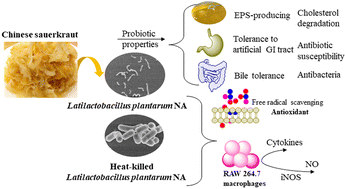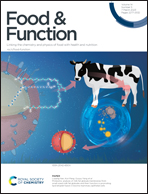Probiotic activity of ropy Lactiplantibacillus plantarum NA isolated from Chinese northeast sauerkraut and comparative evaluation of its live and heat-killed cells on antioxidant activity and RAW 264.7 macrophage stimulation†
Abstract
Lactic acid bacteria are known to have a positive impact on health and considered as functional supplements and additives. This study aimed to evaluate the probiotic properties of ropy Latilactobacillus isolated from Chinese northeast sauerkraut and to determine the antioxidant and immunoregulatory activities of its heat-killed cells compared to its live strains to assess its functional activity. After the analysis of the 16r DNA and phylogenetic tree, it was identified as a Lactiplantibacillus plantarum and named L. plantarum NA. L. plantarum NA was resistant to simulated gastrointestinal conditions in vitro. In addition, L. plantarum NA exhibited cholesterol degradation, antibiotic susceptibility, and antibacterial activity. Heat-killed L. plantarum NA exhibited antioxidant and immune-stimulating activities similar to live cells, which may be associated with the undamaged overall structure after heating. The results of antioxidant activity analysis suggested that both live and heat-killed L. plantarum NA possessed capacity for scavenging free radicals, including 2,2-diphenyl-1-picryl-hydrazyl (DPPH), 2,2′-azino-bis-(3-ethylbenzthiazoline-6-sulfonic acid) (ABTS), hydroxyl radicals and superoxide radicals. The ABTS scavenging activity of heat-killed cells (38%) was significantly higher than that of viable (19%) L. plantarum NA. Furthermore, RAW 264.7 macrophages treated with L. plantarum NA induced the production of nitric oxide, cytokines (IL-6 and TNF-α), and reactive oxygen species (ROS). The NO/iNOS signaling pathway could be activated by L. plantarum NA and promoted NO production. Both live and heat-killed cells had a potential impact on the immunomodulatory activity, with different dosages. These results suggest that the novel L. plantarum NA isolated from Chinese northeast sauerkraut could be useful as a probiotic strain and applied to functional food processing and pharmaceutical fields as a potential immunomodulator.



 Please wait while we load your content...
Please wait while we load your content...